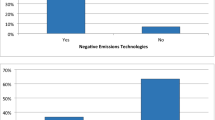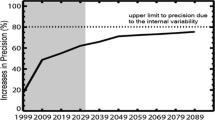Abstract
There has been much work on the value of learning about climate and the value of information regarding the climatic system. The present research moves beyond an abstract hypothesis about future learning and considers concrete Earth Observing Systems that could enhance knowledge of the climatic system and better inform decision makers. This study shows how real options theory in combination with the social cost of carbon may help to calculate the value of information regarding equilibrium climate sensitivity and estimate the relative advantages of two different Earth Observing Systems (EOSs) for learning about ECS. One system aims to improve measurements of decadal global temperature increase and another targets measurements of decadal change of global cloud radiative effect. The paper concludes that a new EOS that substantially reduces the uncertainty in cloud radiative effect would be expected to have more value than improving estimations of the global surface temperature alone.










Similar content being viewed by others
Notes
Cloud radiative effect or CRE has also often been called cloud radiative forcing (CRF). The quantities are identically defined. We use CRE in this paper as it has become the more common usage
There are some differences in our assumptions: we assumed 10-year instrument lifetime (tau cal) for the CRE obs and only 5 years for the GST. This means that calibration errors decrease in time more slowly for CRE than for GST. We did this to be consistent with the previous papers and because the weather system tends to update its instruments more often on orbit than research climate data. If the world were to implement a designed climate observing system, then this would likely change to 5 years for CRS as well.
References
Cooke, R. M., Golub, A., Wielicki, B. A., Young, D. F., Mlynczak, M. G., & Baize, R. R. (2015). Integrated assessment modeling of value of information in Earth Observing Systems. Climate Policy ISSN: 1469-3062 (Print) 1752-7457 (Online) Journal homepage: http://www.tandfonline.com/loi/tcpo20.
Cooke, R. M., Wielicki, B. A., Young, D. F., & Mlynczak, M. G. (2013). Value of information for climate observing systems. Environment, Systems and Decisions., 34, 98–109. https://doi.org/10.1007/s10669-013-9451-8.
Cooke, R. M., Golub, A., Wielicki, B., Mlynczak, M., Young, D., & Baize, R. R. (2016). Real option value for new measurements of cloud radiative forcing. RFF DP, 16–19 http://www.rff.org/research/publications/real-option-value-new-measurements-cloud-radiative-forcing.
Dessler, A. E. (2013). Observations of climate feedbacks over 2000–2010 and comparisons to climate models. Journal of Climate, 26, 333–342. https://doi.org/10.1175/JCLI-D-11-00640.1.
Dowell et al., (2013). Strategy towards an architecture for climate monitoring from space. WMO/CGMS/CEOS. 38pp.
Dufresne, J.-L., & Bony, S. (2008). An assessment of the primary sources of spread of global warming estimates from coupled ocean-atmosphere models. Journal of Climate, 21, 5135–5144. https://doi.org/10.1175/2008JCLI2239.1.
Fox, N. Kaiser-Weiss, A. Schmutz, W. Thome, K. Young, D. Wielicki, B. Winkler, R. & Woolliams, E. Accurate radiometry from space: an essential tool for climate studies. https://doi.org/10.1098/rsta.2011.0246.
GCOS. (2016). Implementation plan, 2016. WMO, GCOS-200 315pp.
Goldberg, M., et al. (2011). The global space-based inter-calibration system (GSICS). Bulletin of the American Meteorological Society, 92, 467–475.
Hanea, et al. (2017). Hanea, A. M., G. F. Nane, R. M. Cooke, B. A. Wielicki, 2018: Climate trend uncertainty quantification with non-parametric Bayesian networks. Journal of Risk Research, accepted. https://doi.org/10.1080/13669877.2018.1437059.
Hope, C. (2015). The $10 trillion value of better information about the transient climate response. Philosophical Transactions of the Royal Society A, 373, 20140429. https://doi.org/10.1098/rsta.2014.0429.
IPCC. (2013). In T. F. Stocker, D. Qin, G.-K. Plattner, M. Tignor, S. K. Allen, J. Boschung, A. Nauels, Y. Xia, V. Bex, & P. M. Midgley (Eds.), Climate change 2013: the physical science basis. Contribution of Working Group I to the Fifth Assessment Report of the Intergovernmental Panel on Climate Change. Cambridge, United Kingdom and New York, NY, USA, 1535 pp: Cambridge University Press. https://doi.org/10.1017/CBO9781107415324.
IWGSCC (Interagency Working Group on Social Cost of Carbon). (2010). Social cost of carbon for regulatory impact analysis under Executive Order 12866, Appendix 15a (p. 53). Washington, DC: US Government.
IWGSCC (Interagency Working Group on Social Cost of Carbon). (2013). Technical support document: technical update of the social cost of carbon for regulatory impact analysis under Executive Order 12866. Washington, DC: US Government. May 2013, revised Nov. 2013.
Karl, T. R., S. J. Hassol, C. D. Miller, & W. L. Murray (2006). Synthesis and assessment product 1.1 report by the U.S. Climate Change Science Program and the Subcommittee on Global Change Research. U.S. Climate Change Science Program, April, 2006, 164 pp.
Kelly, D. L., & Kolstad, C. D. (1999). Bayesian learning, growth, and pollution. Journal of Economic Dynamics and Control, 23(4), 491–518.
Kopp, G., Smith, P., Belting, C., Castleman, Z., Drake, G., Espejo, J., Heuerman, K., Lanzi, J., & Stuchlik, D. (2017). Radiometric flight results from the HyperSpectral Imager for Climate Science (HySICS). Geosci. Instrum. Method. Data Syst., 6, 169–191. https://doi.org/10.5194/gi-6-169-2017.
Leroy, S. S., Anderson, J. G., & Ohring, G. (2008). Climate signal detection times and constraints on climate benchmark accuracy requirements. Journal of Climate, 21, 184–846.
Loeb, N. G., Doelling, D. R., Wang, H., Su, W., Nguyen, C., Corbett, J. G., Liang, L., Mitrescu, C., Rose, F. G., & Kato, S. (2018). Clouds and the Earth’s Radiant Energy System (CERES) Energy Balanced and Filled (EBAF) top-of-atmosphere (TOA) Edition-4.0 Data Product. Journal of Climate, 31, 24. https://doi.org/10.1175/JCLI-D-17-0208.1.
McInerney, D., Lempert, R., & Keller, K. (2011). What are robust strategies in the face of uncertain climate threshold responses? Climatic Change, 112, 547–568. https://doi.org/10.1007/s10584-011-0377-1.
NRC. (2007). Earth science and applications from space: national imperatives for the next decade and beyond. Washington, D.C: National Academy Press 428 pp.
National Academies of Sciences, Engineering, and Medicine. (2018). Thriving on our changing planet: a decadal strategy for earth observation from space. Washington, DC: The National Academies Press. https://doi.org/10.17226/24938.
National Academies of Sciences, Engineering, and Medicine. (2017). Valuing climate damages: updating estimation of the social cost of carbon dioxide. Washington, DC: The National Academies Press. https://doi.org/10.17226/24651.
Nordhaus, W. D. (2008). A question of balance: weighing the options on global warming policies. New Haven, CT: Yale University Press.
National Academies of Sciences, Engineering, and Medicine. (2015). Continuity of NASA Earth observations from space: a value framework. Washington, DC: The National Academies Press.
Nordhaus, W., & Sztorc, P. (2013). DICE 2013R: introduction and user’s manual. 2nd ed. http://www.econ.yale.edu/~nordhaus/homepage/documents/DICE_Manual_103113r2.pdf
O’Neill, B. C., Crutzen, P., Gruebler, A., Duong, M. H., Keller, K., Kolstad, C., Koomey, J., Lange, A., Obersteiner, M., Oppenheimer, M., Pepper, W., Sanderson, W., Schlesinger, M., Treich, N., Ulph, A., Webster, M., & Wilson, C. (2006). Learning and climate change. Climate Policy, 6, 585–589.
Soden, B. J., & Vecchi, G. A. (2011). The vertical distribution of cloud feedback in coupled ocean–atmosphere models. Geophysical Research Letters, 38, L12704. https://doi.org/10.1029/2011GL047632.
Soden, B. J., Held, I. M., Colman, R., Shell, K. M., Kiehl, J. T., & Shields, C. A. (2008). Quantifying climate feedbacks using radiative kernels. Journal of Climate, 21, 3504–3520.
Webster, M. D., Jakobovits, L., & Norton, J. (2008). Learning about climate change and implications for near-term policy. Climatic Change, 89, 67–85. https://doi.org/10.1007/s10584-008-9406-0.
Wielicki, B. A., Young, D. F., Mlynczak, M. G., Thome, K. J., Leroy, S., Corliss, J., Anderson, J. G., Ao, C. O., Bantges, R., Best, F., Bowman, K., Brindley, H., Butler, J. J., Collins, W., Dykema, J. A., Doelling, D. R., Feldman, D. R., Fox, N., Huang, X., Holz, R., Huang, Y., Jin, Z., Jennings, D., Johnson, D. G., Jucks, K., Kato, S., Kirk-Davidoff, D. B., Knuteson, R., Kopp, G., Kratz, D. P., Liu, X., Lukashin, C., Mannucci, A. J., Phojanamongkolkij, N., Pilewskie, P., Ramaswamy, V., Revercomb, H., Rice, J., Roberts, Y., Roithmayr, C. M., Rose, F., Sandford, S., Shirley, E. L., Smith, W. L., Soden, B., Speth, P. W., Sun, W., Taylor, P. C., Tobin, D., & Xiong, X. (2013). Achieving climate change absolute accuracy in orbit. Bulletin of the American Meteorological Society, 94, 1519–1539. https://doi.org/10.1175/BAMS-D-12-00149.1.
Trenberth, K. E., Belward, A., Brown, O., Haberman, E., Karl, T. R., Running, S., Ryan, B., Tanner, M., & Wielicki, B. A. (2012). In G. R. Asrar & J. W. Hurrell (Eds.), Challenges of a sustained climate observing system, in the monograph: Climate science for serving society: research, modelling and prediction priorities. Berlin: Springer.
Weatherhead, B., B. A. Wielicki, V. Ramaswamy, M. Abbott, T. Ackerman, B. Atlas, G. Brasseur, L. Bruhwiler, T. Busalacchi, J. Butler, C. T. M. Clack, R. Cooke, L. Cucurull, S. Davis, J. M. English, D. Fahey, S. S. Fine, J. K. Lazo, S. L., N. Loeb, E. Rignot, B. Soden, D. Stanitski, G. Stephens, B. Tapley, A. M. Thompson, K. Trenberth, D. Wuebbles, 2017: Designing the climate observing system of the future. Earth’s Future, 23pp, https://doi.org/10.1002/2017EF000627
Zhou, C., Zelinka, M. D., Dessler, A. E., & Klein, S. A. (2015). The relationship between interannual and long-term cloud feedbacks. Geophysical Research Letters, 42, 10,463–10,469. https://doi.org/10.1002/2015GL066698.
Author information
Authors and Affiliations
Corresponding author
Additional information
Publisher’s Note
Springer Nature remains neutral with regard to jurisdictional claims in published maps and institutional affiliations.
This reports on work done under contract NNX13AQ72A with support from the NASA Applications Program.
Rights and permissions
About this article
Cite this article
Cooke, R.M., Golub, A., Wielicki, B. et al. Monetizing the Value of Measurements of Equilibrium Climate Sensitivity Using the Social Cost of Carbon. Environ Model Assess 25, 59–72 (2020). https://doi.org/10.1007/s10666-019-09662-0
Received:
Accepted:
Published:
Issue Date:
DOI: https://doi.org/10.1007/s10666-019-09662-0




